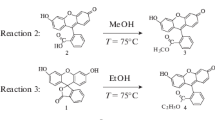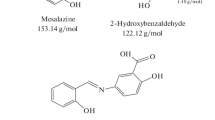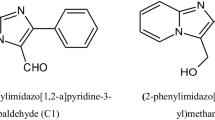Abstract
The purpose of the study is to synthesize and characterize a new arylazo compound 1,7-bis(2-hydroxyphenyl)-4-(phenylhydrazono)hepta-1,6-diene-3,5-dione (HPHDD) . The corrosion inhibition behavior of the compound on mild steel in 1 M HCl was investigated using weight loss method, electrochemical impedance spectroscopy, and potentiodynamic measurements. The results revealed that this arylazo compound effectively inhibited the corrosion reaction in HCl medium. The surface analysis indicated that this inhibitor was strongly adsorbed on the metal surface. The electrochemical studies at different temperatures showed the thermal stability of the inhibitor. Quantum chemical studies were performed using DFT at the B3LYP/6-31G (d, p)basis set. Contrary to the carcinogenic property of usual anti-corrosive substances, the in vitro cytotoxic studies of the newly synthesized arylazo derivative against Dalton lymphoma ascites cells confirm the anti-tumor properties of the compound.















Similar content being viewed by others
References
Akrout H, Maximovitch S, Bousselmi L, Triki E, Dalard F (2007) Evaluation of corrosion non toxic inhibitor adsorption for steel in near neutral solution: L (+) ascorbic acid. Mater Corros 58:202–206
Akrout H, Bousselmi L, Triki E, Maximovitch S, Dalard F (2005) Adsorption mechanism of non-toxic organic inhibitors on steel in solutions at pH 8 determined by electrochemical quartz crystal microbalance measurements. Mater Corros 56:185–191
Hosseini MG, Ehteshamzadeh M, Shahrabi T (2007) Protection of mild steel corrosion with Schiff bases in 0.5 M H2SO4 solution. Electrochim Acta 52:3680–3685
Emregül KC, Atakol O (2004) Corrosion inhibition of iron in 1 M HCl solution with Schiff base compounds and derivatives. Mater Chem Phys 83:373–379
Aysel Yurt ÖA (2011) Diphenolic Schiff bases as corrosion inhibitors for aluminium in 0.1 M HCl: potentiodynamic polarisation and EQCM investigations. Corros Sci 53:3725–3732
Erbil M, Tüken T, Demir F, Kıcır N, Sıg G (2012) Inhibition effect of 1-ethyl-3-methylimidazolium dicyanamide against steel corrosion. Corros Sci 59:110–118
Soliman SA, Metwally MS, Selim SR, Bedair MA, Abbas MA (2014) Corrosion inhibition and adsorption behavior of new Schiff base surfactant on steel in acidic environment: experimental and theoretical studies. J Ind Eng Chem 20:4311–4320
Arab ST, Noor EAA (1993) Inhibition of acid corrosion of steel by some S-alkylisothiouronium Iodides. Corrosion 49:122–129
Elmsellem H, Harit T, Aouniti A, Malek F (2015) Adsorption properties and inhibition of mild steel corrosion in 1 M HCl solution by some bipyrazolic derivatives: experimental and theoretical investigations. Prot Met Phys Chem Surf 51:873–884
Chen S, Kar T (2012) Theoretical investigation of inhibition efficiencies of some schiff bases as corrosion inhibitors of aluminum. Int J Electrochem Sci 7:6265–6275
Belghiti ME et al (2016) Anti-corrosive properties of 4-amino-3,5-bis(disubstituted)-1,2,4-triazole derivatives on mild steel corrosion in 2 M H3PO4 solution: experimental and theoretical studies. J Mol Liq 216:874–886
Agrawal YK, Talati JD, Shah MD, Desai MN, Shah NK (2004) Schiff bases of ethylenediamine as corrosion inhibitors of zinc in sulphuric acid. Corros Sci 46:633–651
Oguzie EE (2005) Corrosion inhibition of mild steel in hydrochloric acid solution by methylene blue dye. Mater Lett 59:1076–1079
Zucchi F, Trabanelli G, Brunoro G (1992) The influence of the chromium content on the inhibitive efficiency of some organic compounds. Corros Sci 33:1135–1139
Noor Hasima, Bharat B, Aggarwal (2012) Cancer-linked targets modulated by Curcumin. Int J Biochem Mol Biol 3:328–351
Mark R, Kelley D, Logden, Mellssa L, Fishell (2014) Targetting DNA repair pathways for cancer treatment: what’s new. Future Oncol 10:1215–1237
Krishnankutty K, John VD (2003) Synthesis, characterization, and antitumour studies of metal chelates of some synthetic curcuminoids. Synth React Inorg Met Org Chem 33:343–358
Krishnankutty K, Basheer M, Kamalakshy D (2009) Arylazo derivatives of some fluorinated β-diketones and their metal complexes. J Iran Chem Res 2:111–119
John VD, Ummathur MB, Krishnankutty K (2013) Synthesis, characterization, and antitumour studies of some curcuminoid analogues and their aluminum complexes. J Coord Chem 66:1508–1518
Tan SF, Ang KP, How GF (1991) Intermolecular and intramolecular hydrogen bonding in 5-pyridylmethylenehydantoins: IR and NMR study. J Phys Org Chem 4, 170–176
Li X, Deng S, Xie X (2014) Inhibition effect of tetradecylpyridinium bromide on the corrosion of cold rolled steel in 7.0 M H3PO4. Arab J Chem. https://doi.org/10.1016/j.arabjc.2014.05.004
Elkacimi Y, Achnin M, Aouine Y, Touhami ME, Alami A (2012) Inhibition of mild steel corrosion by some phenyltetrazole substituted compounds in hydrochloric acid. Port Electrochim Acta 30:53–65
Manjula P, Manonmani S, Jayaram P, S. R (2001) Corrosion behaviour of carbon steel in the presence of N-cetyl-N, N, N- trimethylammonium bromide, zinc and calcium gluconate. Anti-Corros Methods Mater 48:319–324
Bedair MA, Soliman SA, Metwally MS (2016) Synthesis and characterization of some nonionic surfactants as corrosion inhibitors for steel in 1.0 M HCl. J Ind Eng Chem 41:10–22
Singh A, Avyaya JN, Quraishi MA (2012) Schiff’ s base derived from the pharmaceutical drug Dapsone (DS) as a new and effective corrosion inhibitor for mild steel in hydrochloric acid. Res Chem Intermed. https://doi.org/10.1007/s11164-012-0577-y
Gokmen SI, Erbil M (2016) Assessment of the inhibition efficiency of 3, 4-diaminobenzonitrile against the corrosion of steel. Corros Sci 102, 437–445
Manivel A, Ramkumar S, Wu JJ, Asiri AM, Anandan S (2014) Exploration of (S)-4, 5, 6, 7-tetrahydrobenzo [d] thiazole-2, 6-diamine as feasible corrosion inhibitor for mild steel in acidic media. J Environ Chem Eng 2:463–470
Hassan HH (2007) Inhibition of mild steel corrosion in hydrochloric acid solution by triazole derivatives. Part II: time and temperature effects and thermodynamic treatments. Electochim Acta 53:1722–1730
Yurt A, Balaban A, Kandemir SU, Bereket G, Erk B (2004) Investigation on some Schiff bases as HCl corrosion inhibitors for carbon steel. Mater Chem Phys 85:420–426
Hassan HH, Abdelghani E, Amin MA (2007) Inhibition of mild steel corrosion in hydrochloric acid solution by triazole derivatives Part I. Polarization and EIS studies. Electochim Acta 52:6359–6366
Bouanis M et al (2016) Corrosion inhibition performance of HCl solution: gravimetric, electrochemical and XPS studies. Appl Surf Sci 389:952–966
Mazumder MAJ, Al-Muallem HA, Faiz M, Ali SA (2014) Design and synthesis of a novel class of inhibitors for mild steel corrosion in acidic and carbon dioxide-saturated saline media. Corros Sci 87:187–198
Solmaz R, Kardas G (2008) Investigation of adsorption and inhibitive effect of 2-mercaptothiazoline on corrosion of mild steel in hydrochloric acid media. Electochim Acta 53:5941–5952
Xu B, Liu Y, Yin X, Yang W, Chen Y (2013) Experimental and theoretical study of corrosion inhibition of 3-pyridinecarbozalde thiosemicarbazone for mild steel in hydrochloric acid. Corros Sci 74:206–213
Zhou X, Yang H, Wang F (2011) Electrochimica Acta [BMIM] BF 4 ionic liquids as effective inhibitor for carbon steel in alkaline chloride solution. Electrochim Acta 56:4268–4275
Likhanova NV et al (2010) The effect of ionic liquids with imidazolium and pyridinium cations on the corrosion inhibition of mild steel in acidic environment. Corros Sci 52:2088–2097
El-lateef HMA (2014) Experimental and computational Investigation on the corrosion inhibition characteristics of mild steel by some novel synthesized imines in hydrochloric acid solutions. Corros Sci. https://doi.org/10.1016/j.corsci.2014.11.040
Acknowledgements
The authors are grateful to University Grant Commission for the funding for FDP, P.G., and Research Department of Chemistry, Christ College, Irinjalakuda, Calicut University, National Institute of Technology Trivandrum, CUSAT Cochin, and Amala Cancer Research Centre, Thrissur, Kerala.
Funding
Funding was provided by UGC-DAE Consortium for Scientific Research, University Grants Commission (IN) (Grant No. FIP/12 Plan/KLCA 020).
Author information
Authors and Affiliations
Corresponding author
Rights and permissions
About this article
Cite this article
Cherappanath, R.J., John, V.D. Synthesis, Characterization, Anti-corrosive/Anti-tumor Applications of a New Type Arylazo Compound 1,7-Bis(2-Hydroxy Phenyl)-4-(Phenyl Hydrazono)-Hepta-1,6-Diene-3,5-Dione. J Bio Tribo Corros 4, 66 (2018). https://doi.org/10.1007/s40735-018-0183-7
Received:
Revised:
Accepted:
Published:
DOI: https://doi.org/10.1007/s40735-018-0183-7




